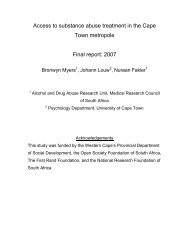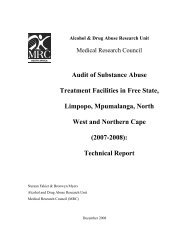Pan-African Conference 21 - 24 July 2002 Inter-Continental Hotel ...
Pan-African Conference 21 - 24 July 2002 Inter-Continental Hotel ...
Pan-African Conference 21 - 24 July 2002 Inter-Continental Hotel ...
You also want an ePaper? Increase the reach of your titles
YUMPU automatically turns print PDFs into web optimized ePapers that Google loves.
Abstracts 10/22/02 11:26 AM Page 23<br />
The ultimate aim is to make the web page an ever-evolving self-learning<br />
system that provides credible information in a fun and interactive style that<br />
remains relevant to the target population.<br />
ABSTRACT NO. 190. Influence of new IT on food chemistry and human<br />
nutrition course for students of pharmacy in Poland<br />
Schlegel-Zawadzka M*, Przyslawski J**, Bertrandt J ***, Klos A***<br />
*Department of Continuing Education and Postgraduate Studies, and Department of<br />
Food Chemistry and Nutrition, Collegium Medicum Jagiellonian University, 9<br />
Medyczna Str., 30-688 Krakow<br />
**Chair and Department of Bromatology and Human Nutrition, Medical Academy, 42<br />
Marcelinska Str., 60-345 Poznan<br />
***Military Institute of Hygiene&Epidemiology, 4 Kozielska Str., 01-163 Warszawa;<br />
Poland<br />
Pharmacy education in Poland has a long tradition dating back to the 18th<br />
century. The first pharmacy faculty was established at the Jagiellonian<br />
University in 1783. Almost from the first years students (firstly only men and<br />
in the end of XIX century also women) were taught about proper food and<br />
adequate nutrition.<br />
The XXI century gives a new opportunity to implement high information<br />
technology for lecturing, preparing classes for students and their self-learning.<br />
A new vision of Polish chemists and a role of pharmacists in health promotion<br />
and pharmaceutical care need to use new sources of collecting information and<br />
spreading it among patients.<br />
Students of pharmacy in Poland have from 75 to 90 lecture hours (each hour 45<br />
minutes) at the fourth year of study, a course which is called bromatology<br />
(broma – food, logos – science in Greek), in English it is translated as food<br />
chemistry and nutrition. This course is giving students a basic knowledge<br />
about food, nutrition value of food, sources of nutrients, their influence on<br />
human health and interactions between food and drug. Some departments in<br />
Poland prepare special modules about civilization diseases and their<br />
connection with nutrition. There are lectures and classes. During the last<br />
semester (5th year) students should prepare the master thesis supervised by an<br />
independent university teacher with a high degree. Moreover, during study<br />
they have an informatics course at the first year.<br />
Computers were implemented in bromatology for the first time in 19881. It was<br />
a programme to teach the proper nutrition behavior to students of pharmacy.<br />
BASIC language was used to write it. It calculated the daily intake of different<br />
nutrients in diets. Later on students started to write their master work using<br />
their own Amstrad’s or next PC computers. Statistical programmes were not<br />
very popular at that time. Almost all statistical procedures were written by<br />
teachers, who were fascinated by these new possibilities.<br />
Last few years of Microsoft’s and StatSoft’s campaigns with decreasing prices<br />
for official programmes allowed Universities to buy new academic versions.<br />
Courses prepared by the Polish Center of StatSoft increased the number of<br />
academic scientists to use in the routine such programme as Statistica work<br />
with students. Almost all students in some bromatology departments are using<br />
this programme during statistical estimation. Specially, some modules (tables)<br />
are very useful for the nutrition questionnaire study. During classes,<br />
programme FOOD prepared by the Polish National Food and Nutrition<br />
Institute is used for seeking nutrient deficits in daily diets by students<br />
themselves. An access to <strong>Inter</strong>net databases free of charge for students gives<br />
them opportunity to prepare special presentation, now more and more popular<br />
with the use of the Power Point programme. An increasing knowledge how to<br />
use computer is also visible during operating different apparatus –<br />
chromatographs, atomic absorption apparatus. The first version of the specially<br />
prepared programme on CD-ROM gives information about drug and food<br />
interactions. It is very useful for both students and professionals.<br />
All this opportunity will allow to prepare the students of pharmacy to be good<br />
advisors for patients and to resolve previously unclear problems. But high<br />
technology will never replace the pharmacists’ personal contact and chats with<br />
patients, who in Poland have freedom to choose the most familiar pharmacy.<br />
References.<br />
1. Schlegel M, Zachwieja Z, Plewa J. Dydaktyczny program komputerowy do<br />
nauczania zasad prawidlowego zywienia studentow farmacji. Probl Szkoln<br />
Nauk Med. 1989, 14, 41-44.<br />
ABSTRACTS<br />
ABSTRACT NO. 194. USE OF INFORMATION TECHNOLOGY TO<br />
DISSEMINATE NUTRITION MESSAGES RELATED TO HIV/AIDS TO<br />
THE RURAL POPULATION IN MALAWI<br />
Chawanje CM 1 , Chiwona-Karltun Linley 2<br />
1 University of Malawi The Polytechnic P/Bag 303 Chichiri Blantyre 3 Malawi<br />
2Department of Plant biology Swedish University of agricultural Sciences Box 7050<br />
SE-75007 Uppsala, Sweden<br />
The importance of good nutrition in the prevention of and coping with<br />
HIV/AIDS is well recognized. Malawi has a population of 11 million people, of<br />
which 77 % lives in the rural areas and 41 % is illiterate. HIV/AIDS is rampant.<br />
Although printed information on nutrition as related to HIV/AIDS is readily<br />
available, it cannot be assimilated by illiterate population. For example, the two<br />
CD-Roms (Nutrition in Africa 1 and 2) for nutrition training of undergraduates<br />
prepared by <strong>African</strong> professionals during a training programme in Sweden, are<br />
not accessible to illiterate people. It is therefore essential to develop computerbased<br />
learning material on nutrition as related to HIV/AIDS for such people.<br />
We propose to develop computer based and animated nutrition learning<br />
material using graphics and cartoons that convey messages on the relationship<br />
between nutrition and HIV/AIDS that are readily assimilated by illiterate<br />
people, particularly in rural areas where electricity is readily available. The<br />
main objective is to use information technology to disseminate nutrition<br />
messages to rural illiterate communities targeted at the prevention of and<br />
coping with HIV/AIDS.<br />
ABSTRACT NO. 198. NUTRITION EDUCATION AND THE GLOBAL<br />
INFORMATION HIGHWAY: USE OF ON-LINE APPLICATIONS AND<br />
SELECTED PACKAGES.<br />
Sigot Asenath J<br />
Maseno University, P O Private Bag, Maseno Kenya<br />
New and emerging information technologies provide opportunities for<br />
nutrition educators to enhance communication efforts, which can improve the<br />
health and well-being of all people. Computer technologies are providing<br />
viable means of exchanging nutrition information among professionals and<br />
informing and influencing the public. Nutrition education programmes are<br />
available on diskettes, CD-ROM and laser disks that can be used at computer<br />
workstations or stand-alone kiosks. The major types of nutrition education<br />
computer programmes pertain to food composition, food service, nutrient<br />
analysis, recipe management, menu planning, clinical nutrition, drug-nutrient<br />
interactions, health risk assessment, food and nutrition games. In addition to<br />
programmes specific to their field, nutrition educators are also assisted by<br />
general production tools such as graphic packages, computer photo, clip art<br />
collections, and presentation software. The software for public presentations<br />
allows nutrition educators to enhance their talks by incorporating pictures,<br />
sound, animation texts and video. Using word processing and desktop<br />
publishing software, nutrition educators can create professional-looking<br />
newsletters, booklets and educational materials such as posters, cards and<br />
charts to meet diverse needs and give a more personalized image.<br />
The use of on-line applications by nutrition educators is just emerging in<br />
developing countries. With a computer that can communicate with other<br />
computers through telephone line, satellite transmissions or network wires, the<br />
nutrition educator can enter cyberspace or the global information highway.<br />
Nutrition information can be exchanged through electronic mail, internet and<br />
other computer networks; the World Wide Web, electronic databases, electronic<br />
bulletin board systems, faxes and interactive non-commercial television<br />
provide user friendly interface to the Net. <strong>Inter</strong>net can also be used for<br />
interactive teaching in health education promotion via on-line teaching and<br />
interaction with off-campus students at the “Virtual Campus.” It can also<br />
provide a means for communication networking and collaboration among<br />
members of the international nutrition community.<br />
ABSTRACT NO. 206. Training of health professionals in nutrition at the<br />
university of Nairobi, Kenya: Opportunities and challenges in the use of<br />
information technology<br />
Thuita F<br />
P.O. Box 178, Nairobi 00202, Kenya<br />
Training of health professionals in public health nutrition is aimed at equipping<br />
them with knowledge and skills necessary for tackling malnutrition both at<br />
S23

















